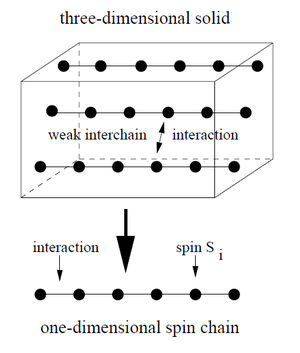S=1/2 and S=1 one dimensional quantum magnets
Why are we interested in one-dimensional magnetism? Magnetism in one dimension are of highly theoretical interest as well as there are a variety of highly interesting experimental systems. Most two-dimensional magnets order at T=0, however, in one-dimensional situation, fluctuations are so strong that at T=0 most magnets are disordered. Because of the strong fluctuations, conventional techniques are normally not applicable. So we need to search for new tools to solve problems. One of the representative way is to use numerical methods. An example is, by numerically evaluation, one found a unique, disorder ground state of the nearest-neighbor isotropic anti-ferromagnetic Heisenberg chain for spins S=1/2, with anti-ferromagnetic spin-spin correlations, referred as quasi long-range ordered.
Haldane's Conjecture
Introduction to Haldane's Conjecture
Haldane conjectured a fundamental difference between spin chains with S an integer and S a half-integer. He mapped out anti-ferromagnetic isotropic Heisenberg chains to an effective low-energy long-wavelength field theory. Here we use effective field theories of anti-ferromagnets to show Haldane's Conjecture.
Let's consider an isotropic anti-ferromagnetic Heisenberg model with nearest neighbor interaction between spins of S length.The Hamiltonian can be expressed as
Assume that local order on short length scales, we can derive an effective long-wavelength low energy Lagrangian for
Where v=2JS is the spin wave velocity, g=2/S is the coupling constant and is the topological angle; is a three-component unit vector field. Then we can do a Wick rotation to get the form of Lagrangian as below:
Where is the Lagrangian of an O(3) nonlinear model and .With differential geometry, we are able to derive that
Here Q is an integer for any field . It's called winding number.
The partition function is
For integer S, it's reduced to the nonlinear -model. And for half-integer S,it can be considered by the Bethe ansatz for S=1/2.
Re-normalize group, we can get the below function.
This function tells us that for any finite S, the flow is to disordered high-temperature limit. Where we regard ,lattice constant a and .
The correlations are antiferromagnetic. They decay with the Ornsterin-Zernike law for two-dimensional space-time.
For , the excitation spectrum is massive-relativistic, with a gap to the ground state and can be depicted as
In the limit of , the finite gap and the correlation length should have the relation with S, demonstrated like
In classic limit, at T=0, ,
Verify Haldane's Conjecture in S=1/2 case
Verify Haldane's Conjecture in S=1 case
Microscopic Description of Haldane Magnets
Quantum Disorder and Lifshitz Points
References
- ↑ Cite error: Invalid
<ref>tag; no text was provided for refs namedUlrich Schollwock











![{\displaystyle Q[{\overset {\rightarrow }{\phi }}]={\frac {1}{\Theta }}\int {d^{2}x}{\mathcal {L}}_{TOP}[{\overset {\rightarrow }{\phi }}]}](https://wikimedia.org/api/rest_v1/media/math/render/svg/0c30eb114e30ba86488e6c701e0dbef9fd417c7f)
![{\displaystyle Z=\int D[{\overset {\rightarrow }{\phi }}]e^{-\int {d^{2}x}{\mathcal {L}}_{NL}}e^{-i\Theta Q[{\overset {\rightarrow }{\phi }}]}\delta \left(|{\overset {\rightarrow }{\phi }}|^{2}\right)}](https://wikimedia.org/api/rest_v1/media/math/render/svg/02305822d102854b016d983d1d1d6ef0f8d542f0)
![{\displaystyle e^{-i\Theta Q[{\overset {\rightarrow }{\phi }}]}={\begin{cases}1&S=interger\\\pm 1&S=half-interger\\\end{cases}}}](https://wikimedia.org/api/rest_v1/media/math/render/svg/47ea91d76456d3188559aeef9253c34f6266be29)




![{\displaystyle \left\langle \mathbf {S} _{i}\cdot \mathbf {S} _{j}\right\rangle \propto \left(-1\right)^{i-j}{\frac {e^{-|i-j|/\xi }}{\sqrt[{2}]{|i-j|}}}}](https://wikimedia.org/api/rest_v1/media/math/render/svg/ab3dc882245b60060cf94b4f024ccff5eeac88a0)

![{\displaystyle E\left(k\right)={\sqrt[{2}]{\Delta ^{2}+v^{2}\left(k-\pi \right)^{2}}}}](https://wikimedia.org/api/rest_v1/media/math/render/svg/b32c5418726edb681a213ead8a4d761e3b771e6f)



